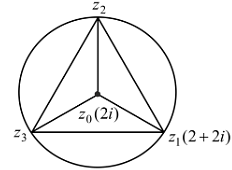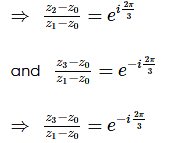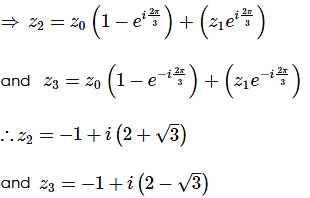JEE Exam > JEE Questions > If one of the vertices of the triangle of ma...
Start Learning for Free
If one of the vertices of the triangle of maximum possible area that can be inscribed in the curve |z − 2i| = 2, is 2 + 2i, then the remaining two vertices are given by
- a)−1 + i(2 + √3)
- b)−1 - i(2 + √3)
- c)−1 + i(2 - √3)
- d)−1 - i(2 - √3)
Correct answer is option 'A,C'. Can you explain this answer?
| FREE This question is part of | Download PDF Attempt this Test |
Most Upvoted Answer
If one of the vertices of the triangle of maximum possible area that ...
Let us assume that z1 = 2 + 2i & z2 & z3 are the remaining two vertices of the inscribed triangle. The curve |z − 2i| = 2 obviously represents a circle.
For the fixed circle, the triangle with maximum possible area should be an equilateral triangle. Hence, the inscribed triangle is an equilateral triangle.
Let us assume that z0 represents the Centroid/circumcentre/orthocentre/incentre of inscribed triangle.
Applying rotation about the point z0. we get


And 


∴ Options (−1 + i(2 + √3) and (−1 + i(2 - √3) are correct.
Free Test
FREE
| Start Free Test |
Community Answer
If one of the vertices of the triangle of maximum possible area that ...
Given Information:
- Maximum area triangle inscribed in the curve |z − 2i| = 2
- One vertex is 2 + 2i
Solution:
Step 1: Finding the Center of the Circle
- The given equation |z − 2i| = 2 represents a circle centered at 2i with radius 2.
Step 2: Finding the Other Vertices
- Since one vertex is at 2 + 2i and the circle is symmetric about the center, the other two vertices must lie on the circle.
Step 3: Applying Symmetry
- Since the circle is symmetric about the real axis, the other two vertices will be symmetrical to 2 + 2i across the real axis.
Step 4: Calculating the Other Vertices
- The vertices symmetrical to 2 + 2i across the real axis are 2 - 2i and -2 + 2i.
Step 5: Simplifying the Vertices
- Rearranging the vertices gives -2 + 2i as -1 + i(2√3) and 2 - 2i as -1 - i(2√3).
Therefore, the remaining two vertices are -1 + i(2√3) and -1 - i(2√3), which corresponds to options A and C.
Attention JEE Students!
To make sure you are not studying endlessly, EduRev has designed JEE study material, with Structured Courses, Videos, & Test Series. Plus get personalized analysis, doubt solving and improvement plans to achieve a great score in JEE.

|
Explore Courses for JEE exam
|

|
Similar JEE Doubts
If one of the vertices of the triangle of maximum possible area that can be inscribed in the curve |z − 2i| = 2, is 2 + 2i, then the remaining two vertices are given bya)−1 + i(2 + √3)b)−1 - i(2 + √3)c)−1 + i(2 - √3)d)−1 - i(2 - √3)Correct answer is option 'A,C'. Can you explain this answer?
Question Description
If one of the vertices of the triangle of maximum possible area that can be inscribed in the curve |z − 2i| = 2, is 2 + 2i, then the remaining two vertices are given bya)−1 + i(2 + √3)b)−1 - i(2 + √3)c)−1 + i(2 - √3)d)−1 - i(2 - √3)Correct answer is option 'A,C'. Can you explain this answer? for JEE 2025 is part of JEE preparation. The Question and answers have been prepared according to the JEE exam syllabus. Information about If one of the vertices of the triangle of maximum possible area that can be inscribed in the curve |z − 2i| = 2, is 2 + 2i, then the remaining two vertices are given bya)−1 + i(2 + √3)b)−1 - i(2 + √3)c)−1 + i(2 - √3)d)−1 - i(2 - √3)Correct answer is option 'A,C'. Can you explain this answer? covers all topics & solutions for JEE 2025 Exam. Find important definitions, questions, meanings, examples, exercises and tests below for If one of the vertices of the triangle of maximum possible area that can be inscribed in the curve |z − 2i| = 2, is 2 + 2i, then the remaining two vertices are given bya)−1 + i(2 + √3)b)−1 - i(2 + √3)c)−1 + i(2 - √3)d)−1 - i(2 - √3)Correct answer is option 'A,C'. Can you explain this answer?.
If one of the vertices of the triangle of maximum possible area that can be inscribed in the curve |z − 2i| = 2, is 2 + 2i, then the remaining two vertices are given bya)−1 + i(2 + √3)b)−1 - i(2 + √3)c)−1 + i(2 - √3)d)−1 - i(2 - √3)Correct answer is option 'A,C'. Can you explain this answer? for JEE 2025 is part of JEE preparation. The Question and answers have been prepared according to the JEE exam syllabus. Information about If one of the vertices of the triangle of maximum possible area that can be inscribed in the curve |z − 2i| = 2, is 2 + 2i, then the remaining two vertices are given bya)−1 + i(2 + √3)b)−1 - i(2 + √3)c)−1 + i(2 - √3)d)−1 - i(2 - √3)Correct answer is option 'A,C'. Can you explain this answer? covers all topics & solutions for JEE 2025 Exam. Find important definitions, questions, meanings, examples, exercises and tests below for If one of the vertices of the triangle of maximum possible area that can be inscribed in the curve |z − 2i| = 2, is 2 + 2i, then the remaining two vertices are given bya)−1 + i(2 + √3)b)−1 - i(2 + √3)c)−1 + i(2 - √3)d)−1 - i(2 - √3)Correct answer is option 'A,C'. Can you explain this answer?.
Solutions for If one of the vertices of the triangle of maximum possible area that can be inscribed in the curve |z − 2i| = 2, is 2 + 2i, then the remaining two vertices are given bya)−1 + i(2 + √3)b)−1 - i(2 + √3)c)−1 + i(2 - √3)d)−1 - i(2 - √3)Correct answer is option 'A,C'. Can you explain this answer? in English & in Hindi are available as part of our courses for JEE.
Download more important topics, notes, lectures and mock test series for JEE Exam by signing up for free.
Here you can find the meaning of If one of the vertices of the triangle of maximum possible area that can be inscribed in the curve |z − 2i| = 2, is 2 + 2i, then the remaining two vertices are given bya)−1 + i(2 + √3)b)−1 - i(2 + √3)c)−1 + i(2 - √3)d)−1 - i(2 - √3)Correct answer is option 'A,C'. Can you explain this answer? defined & explained in the simplest way possible. Besides giving the explanation of
If one of the vertices of the triangle of maximum possible area that can be inscribed in the curve |z − 2i| = 2, is 2 + 2i, then the remaining two vertices are given bya)−1 + i(2 + √3)b)−1 - i(2 + √3)c)−1 + i(2 - √3)d)−1 - i(2 - √3)Correct answer is option 'A,C'. Can you explain this answer?, a detailed solution for If one of the vertices of the triangle of maximum possible area that can be inscribed in the curve |z − 2i| = 2, is 2 + 2i, then the remaining two vertices are given bya)−1 + i(2 + √3)b)−1 - i(2 + √3)c)−1 + i(2 - √3)d)−1 - i(2 - √3)Correct answer is option 'A,C'. Can you explain this answer? has been provided alongside types of If one of the vertices of the triangle of maximum possible area that can be inscribed in the curve |z − 2i| = 2, is 2 + 2i, then the remaining two vertices are given bya)−1 + i(2 + √3)b)−1 - i(2 + √3)c)−1 + i(2 - √3)d)−1 - i(2 - √3)Correct answer is option 'A,C'. Can you explain this answer? theory, EduRev gives you an
ample number of questions to practice If one of the vertices of the triangle of maximum possible area that can be inscribed in the curve |z − 2i| = 2, is 2 + 2i, then the remaining two vertices are given bya)−1 + i(2 + √3)b)−1 - i(2 + √3)c)−1 + i(2 - √3)d)−1 - i(2 - √3)Correct answer is option 'A,C'. Can you explain this answer? tests, examples and also practice JEE tests.

|
Explore Courses for JEE exam
|

|
Suggested Free Tests
Signup for Free!
Signup to see your scores go up within 7 days! Learn & Practice with 1000+ FREE Notes, Videos & Tests.
























